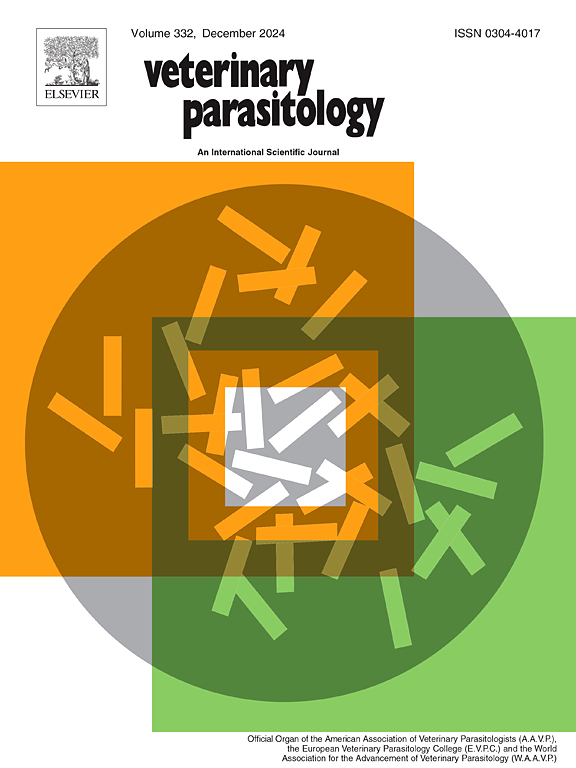Full-length 16S rRNA sequencing revealed an altered microbiome diversity and composition of the jejunum and cecum in chicken infected with Eimeria necatrix
IF 2
2区 农林科学
Q2 PARASITOLOGY
引用次数: 0
Abstract
Avian coccidiosis is an intestinal parasitic disease introduced by Eimeria spp., causing a major economic loss in the world poultry industry. Eimeria necatrix is the most pathogenic species that causes acute coccidiosis in chickens, leading to high mortality. Studies have shown that disruption of the gut environment due to Eimeria infection causes an imbalance in intestinal homeostasis. However, changes in the intestinal microbiota of chickens infected with E. necatrix remain unclear. In the present study, we performed full-length 16S ribosomal RNA amplicon sequencing to assess the effects of E. necatrix infection on jejunal and cecal microbiota at 4 and 10 days post-infection (dpi). The results showed that in both the infected and not infected groups at both time points, the most abundant phyla were Firmicutes, Proteobacteria and Bacteroidetes in the jejunum, and Firmicutes, Bacteroidetes and Proteobacteria in the cecum. The most common genera in the jejunum were Lactobacillus, Limosilactobacillus and Ligilactobacillus at 4 dpi, and Lactobacillus, Limosilactobacillus and Enterococcus in the infected group, and Lactobacillus, Limosilactobacillus and Streptococcus in the control group at 10 dpi. In the cecum, the most common genera were Phocaeicola, Lactobacillus and Alistipes at 4 dpi, and Lactobacillus, Phocaeicola and Alistipes in the infected group, and Lactobacillus, Phocaeicola and Bacteroides in the control group at 10 dpi. A total of 1528 species was annotated, and differences in relative abundance at the species level were analyzed using Lefse method. The results showed that the relative abundance of 23 species, including Acetilactobacillus jinshanensis, Anaerotruncus colihominis, Bacteroides heparinolyticus, Bacteroides ndongoniae, Bariatricus comes, Bifidobacterium gallinarum, Blautia coccoides, Butyricimonas paravirosa, Caproiciproducens galactitolivorans, Clostridioides difficile, Enterococcus cecorum, Escherichia coli, Intestinimonas timonensis, Lachnoanaerobaculum umeaense, Lactobacillus acetotolerans, Ligilactobacillus aviarius, Ligilactobacillus aviarius _B, Limosilactobacillus oris, Limosilactobacillus vaginalis, Megamonas funiformis, Plesiomonas shigelloides, Streptococcus pneumoniae, and Veillonella denticariosi, were significantly different between the infected and not infected groups. Our data reveal that E. necatrix infenction disrupts the integrity of gut microbiota, potentially promoting the establishment and growth of pathogenic bacteria; some species such as Bariatricus comes and Ligilactobacillus aviarius_B may be associated with the pathogenicity of the coccidian parasite and recovery of coccidiosis.
全长度16S rRNA测序揭示了鸡感染鸭源艾美耳球虫后空肠和盲肠微生物多样性和组成的改变
禽球虫病是由艾美耳球虫引起的一种肠道寄生虫病,给世界家禽业造成了重大的经济损失。鸭母艾美耳球虫是引起鸡急性球虫病的致病性最强的物种,导致高死亡率。研究表明,艾美耳球虫感染引起的肠道环境破坏会导致肠道内稳态失衡。然而,感染了necatrie的鸡肠道菌群的变化尚不清楚。在本研究中,我们进行了全长16S核糖体RNA扩增子测序,以评估感染后4天和10天(dpi) necatrie感染对空肠和盲肠微生物群的影响。结果显示,在两个时间点的感染组和未感染组中,空肠中最丰富的门是厚壁菌门、变形菌门和拟杆菌门,盲肠中最丰富的门是厚壁菌门、拟杆菌门和变形菌门。在4 dpi时,空肠中最常见的属为乳酸菌、Limosilactobacillus和liilactobacillus,感染组为乳酸菌、Limosilactobacillus和肠球菌,10 dpi时对照组为乳酸菌、Limosilactobacillus和链球菌。盲肠中4 dpi时最常见的属为Phocaeicola、Lactobacillus和Alistipes,感染组为Lactobacillus、Phocaeicola和Alistipes, 10 dpi时对照组为Lactobacillus、Phocaeicola和Bacteroides。利用Lefse方法对1528种植物的相对丰度差异进行了分析。结果表明:金山乳酸菌、大肠杆菌、溶肝拟杆菌、冬冬拟杆菌、利氏杆菌、鸡双歧杆菌、球蓝杆菌、副病毒丁酸单胞菌、产奶乳杆菌、艰难梭菌、盲肠球菌、大肠埃希菌、耐肠单胞菌、厌氧乳酸杆菌、耐醋乳杆菌、鸟脂乳杆菌、感染组与未感染组间的差异有统计学意义(p < 0.05):鸟脂乳酸菌_B、口脂乳酸菌、阴道脂乳酸菌、异种大单胞菌、志贺单胞菌、肺炎链球菌、牙细微杆菌。我们的数据显示,大肠杆菌感染破坏肠道微生物群的完整性,可能促进致病菌的建立和生长;一些物种如barariricus和liilactobacillus aviarius_B可能与球虫寄生虫的致病性和球虫病的恢复有关。
本文章由计算机程序翻译,如有差异,请以英文原文为准。
求助全文
约1分钟内获得全文
求助全文
来源期刊

Veterinary parasitology
农林科学-寄生虫学
CiteScore
5.30
自引率
7.70%
发文量
126
审稿时长
36 days
期刊介绍:
The journal Veterinary Parasitology has an open access mirror journal,Veterinary Parasitology: X, sharing the same aims and scope, editorial team, submission system and rigorous peer review.
This journal is concerned with those aspects of helminthology, protozoology and entomology which are of interest to animal health investigators, veterinary practitioners and others with a special interest in parasitology. Papers of the highest quality dealing with all aspects of disease prevention, pathology, treatment, epidemiology, and control of parasites in all domesticated animals, fall within the scope of the journal. Papers of geographically limited (local) interest which are not of interest to an international audience will not be accepted. Authors who submit papers based on local data will need to indicate why their paper is relevant to a broader readership.
Parasitological studies on laboratory animals fall within the scope of the journal only if they provide a reasonably close model of a disease of domestic animals. Additionally the journal will consider papers relating to wildlife species where they may act as disease reservoirs to domestic animals, or as a zoonotic reservoir. Case studies considered to be unique or of specific interest to the journal, will also be considered on occasions at the Editors'' discretion. Papers dealing exclusively with the taxonomy of parasites do not fall within the scope of the journal.
 求助内容:
求助内容: 应助结果提醒方式:
应助结果提醒方式:


